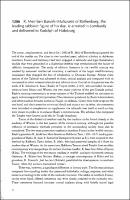Please use this identifier to cite or link to this item:
https://hdl.handle.net/20.500.12202/8565Full metadata record
| DC Field | Value | Language |
|---|---|---|
| dc.contributor.author | Kanarfogel, Ephraim | - |
| dc.date.accessioned | 2022-11-28T22:10:46Z | - |
| dc.date.available | 2022-11-28T22:10:46Z | - |
| dc.date.issued | 1997 | - |
| dc.identifier.citation | Kanarfogel, E. (1997). 1286 R. Meir ben Barukh (Maharam) of Rothenburg, the leading rabbinic figure of his day, is arrested in Lombardy and delivered to Rudolph of Habsburg. In Sander L. Gillman and Jack Zipes (eds.), "The Yale Companion to Jewish Writing and Thought in German Culture, 1096-1996" (pp. 27-34). New Haven: Yale UP. | en_US |
| dc.identifier.isbn | 0300068247 | - |
| dc.identifier.uri | https://hdl.handle.net/20.500.12202/8565 | - |
| dc.description | Scholarly book chapters | en_US |
| dc.description.abstract | The arrest, imprisonment, and death (in 1293) of R. Meir of Rothenburg signaled the end of the tosafist era. For close to two hundred years, rabbinic scholars in Ashkenaz (northern France and Germany) had been engaged in talmudic and legal (halakhahic) studies that were grounded in a dialectical method that revolutionized the nature of rabbinic interpretation. The study of rabbinic literature in the twelfth century was marked by sustained intellectual creativity, a hallmark of the larger twelfth-century renaissance that changed the face of scholarship in Christian Europe. Almost every section of the Talmud was subjected to close, critical analysis and compared with or contrasted to other relevant talmudic and rabbinic texts. Crucial to this process was the work of R. Solomon b. Isaac (Rashi) of Troyes (1040-1105 ), who attended the academies at both Mainz and Worms, the two major yeshivot of the pre-Crusade period. Rashi's running commentary to most tractates of the Talmud enabled his successors to apply new strategics·of interpretation. The comments produced by Rashi's descendents and other students became known as Tosafot, or addenda. Given their wide scope on the one hand, and their attention to textual detail and nuance on the other, the comments were intended to complement or supplement the talmudic text itself as much as they were meant to probe or to enhance Rashi's commentaries. The scholars who composed the Tosafot were known as ba'alei ha-Tosafot (tosafists). | en_US |
| dc.language.iso | en_US | en_US |
| dc.publisher | New Haven: Yale UP | en_US |
| dc.rights | Attribution-NonCommercial-NoDerivs 3.0 United States | * |
| dc.rights.uri | http://creativecommons.org/licenses/by-nc-nd/3.0/us/ | * |
| dc.subject | tosafists | en_US |
| dc.subject | rabbinic literature (qwth century) | en_US |
| dc.subject | Ashke | en_US |
| dc.title | 1286 R. Meir ben Barukh (Maharam) of Rothenburg, the leading rabbinic figure of his day, is arrested in Lombardy and delivered to Rudolph of Habsburg | en_US |
| dc.title.alternative | 1286: 1286 R. Meir ben Barukh (Maharam) of Rothenburg, the leading rabbinic figure of his day, is arrested in Lombardy and delivered to Rudolph of Habsburg | en_US |
| dc.type | Book chapter | en_US |
| dc.contributor.orcid | 0000-0002-7539-7802 | en_US |
| local.yu.facultypage | https://www.yu.edu/faculty/pages/kanarfogel-ephraim | en_US |
| Appears in Collections: | Bernard Revel Graduate School of Jewish Studies (BRGS): Faculty Publications | |
Files in This Item:
| File | Description | Size | Format | |
|---|---|---|---|---|
| Ephraim_Kanarfogel_R_Meir_ben_Barukh_ 27-34.pdf | 650.84 kB | Adobe PDF |  View/Open |
This item is licensed under a Creative Commons License

